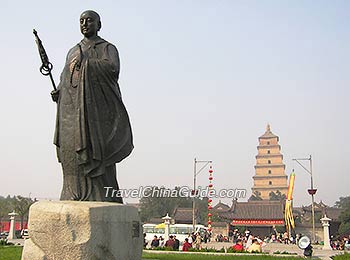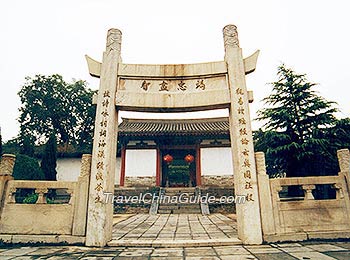Xuanzang
An influential Buddhist monk of the Tang Dynasty (618-907), Xuanzang not only brought Indian sutra to China, but also brought Chinese culture to the West and contributed to the spread of other cultures throughout the world.
Xuanzang's family was very poor and his parents died early, so he became a monk at thirteen years old. In the following years, he studied sutras earnestly, went to many places to call on Buddhist masters and gradually became accomplished in religious works. However, he found there was much divergence in Buddhist theories and it was difficult to get one authoritative and credible theory, so he decided to go to India to further his study of Buddhism.
In the early years of the Tang Dynasty, most regions of the Silk Road were under the control of the Turks (a minority in ancient China), so the government prohibited people from going to the Western Regions. Xuanzang departed stealthily from Chang'an (the present Xi'an), traveled along the Hexi Corridor and reached Liangzhou (Wuwei in Gansu Province). He escaped the toll-gates at the frontier and arrived in Guazhou (now Anxi in Gansu Province) near the Yumenguan Pass that was at the western end of the Great Wall. Under the help of a Tartar, he went out of Yumenguan Pass, traversed deserts for a few days, passed through Yiwu (Hami) and reached Gaochang (Turpan). The King of Gaochang respected Xuanzang very much. He sent Xuanzang 25 people and 30 horses. Then Xuanzang continued his westbound journey by crossing the snow-covered Pamir Plateau and passing Qiuci (Kuche), Suiye (in Kirghizia), Tashkent and Samarkand. After four years of painstaking travel, he finally reached India.
In an ancient temple called the Nalanda Temple, Xuanzang studied India's sutras for five years under the guidance of the Master Jie Xi'an. Afterwards, he traveled across India to exchange ideas with other religious leaders and to give sermons. In 645 AD, he returned to Chang'an with more than 600 sutras. The Tang Emperor Taizong (Li Shimin) gave him a right royal welcome. In the rest of his life, he committed himself to translating the sutras he brought back in Big Wild Goose Pagoda.
Pilgrim to the West in the Tang Dynasty: a book Xuanzang and Bian Ji compiled. It recorded geography, people, customs, history, religions, languages and cultures of about 140 countries, which provided precious data for studying history and geography. It is another big travelogue after Records of the Buddhist Kingdoms written by Fa Xi'an, a respectable monk in Jin Dynasty (265-420). In Pilgrim to the West in the Tang Dynasty, besides the descriptions of many Buddhist sites such as Bamiyan's Buddha and Nalanda Temple, dozens of Buddhist legends were also recorded. Due to its comprehensive and vivid content, it was translated into English, Germany, French and Japanese and widely spread. It is the precious document for the research of China and the world cultural exchange, Buddhism history and national history. In archaeological excavation, experts referred to the clues provided in the book and successfully discovered the sites of many famous temples such as Nalanda Temple, Rajagaha and Sarnath Temple, which fully shows that a great deal of information was accurately placed on record.
Further Reading: Silk Road in Tang Dynasty
Xuanzang's family was very poor and his parents died early, so he became a monk at thirteen years old. In the following years, he studied sutras earnestly, went to many places to call on Buddhist masters and gradually became accomplished in religious works. However, he found there was much divergence in Buddhist theories and it was difficult to get one authoritative and credible theory, so he decided to go to India to further his study of Buddhism.
In the early years of the Tang Dynasty, most regions of the Silk Road were under the control of the Turks (a minority in ancient China), so the government prohibited people from going to the Western Regions. Xuanzang departed stealthily from Chang'an (the present Xi'an), traveled along the Hexi Corridor and reached Liangzhou (Wuwei in Gansu Province). He escaped the toll-gates at the frontier and arrived in Guazhou (now Anxi in Gansu Province) near the Yumenguan Pass that was at the western end of the Great Wall. Under the help of a Tartar, he went out of Yumenguan Pass, traversed deserts for a few days, passed through Yiwu (Hami) and reached Gaochang (Turpan). The King of Gaochang respected Xuanzang very much. He sent Xuanzang 25 people and 30 horses. Then Xuanzang continued his westbound journey by crossing the snow-covered Pamir Plateau and passing Qiuci (Kuche), Suiye (in Kirghizia), Tashkent and Samarkand. After four years of painstaking travel, he finally reached India.
In an ancient temple called the Nalanda Temple, Xuanzang studied India's sutras for five years under the guidance of the Master Jie Xi'an. Afterwards, he traveled across India to exchange ideas with other religious leaders and to give sermons. In 645 AD, he returned to Chang'an with more than 600 sutras. The Tang Emperor Taizong (Li Shimin) gave him a right royal welcome. In the rest of his life, he committed himself to translating the sutras he brought back in Big Wild Goose Pagoda.
|
|
Further Reading: Silk Road in Tang Dynasty
- Last updated on Aug. 09, 2024 by Zoey Gong -

